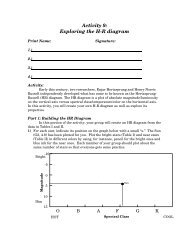Super Sleuths
Super Sleuths
Super Sleuths
- No tags were found...
Create successful ePaper yourself
Turn your PDF publications into a flip-book with our unique Google optimized e-Paper software.
Paper Chromatography
Example QuestionsSuspect SamplesCrime Scene Samples1. Markers #1 and #4 show the bluepigment at the same level on thepaper. Why?2. Two markers, found at the crimescene, were used to write a note(Samples A and B). The knownsamples (suspect samples)represent markers found on thesuspects by the police. Whichtwo known samples are mostsimilar to the markers found atthe crime scene?1 2 3 4 5 6AB3. How many pigments are insample A? Sample B?
Suspect SamplesCrime Scene Samples3. Based on thisevidence, which suspectscould have written thenote?1 2 3 4 5 6ABTable 1. List of suspects and corresponding markers found with suspects.The table below details the suspects on the left and the markers found in their possession with an X.The marker colors and sample numbers are listed along the top of the table.Purple (1) Gold (2) Orange (3) Green (4) Indigo (5) Yellow (6)Ryan X X X X XIzzy X X X XElsa X X X XStuart X XSheldon X X
Physical Evidence! Fingerprints! Hair and fibers! Students should be familiar with using microscopes and analyzing hair and fibersamples! Blood spatter! Students should understand basic spatter patterns:! Passive spatters versus medium to high velocity spatter! Shoeprints and tire treads! Students should be able to identify direction and speed of travel (shoeprints)! Students should be able to compare patterns! Blood Typing
Fingerprints! Students need to beable to identifydifferent fingerprintpatterns by name anduse this information toanalyze fingerprintsand draw conclusions.
Example Questions1. Identify the following types of fingerprints.
2. Identify fingerprint A. Identifyfingerprint B.3. Are fingerprint A andfingerprint B different fromeach other? How?A B
Table 2. List of suspects and their corresponding fingerprints.The table below details the suspects on the left and their fingerprints marked with an X. Thefingerprint types and sample numbers are listed along the top of the table.Arch Whorl Single Loop Double LoopsRyan X XIzzy X X XElsa X X XStuart X X XSheldon X X X X4. Both fingerprints werefound at the crime scene,and they are definitelybelonging to the personthat committed the crime.Based on this evidence,which suspects couldhave been at the crimescene?5. Based on your markerdata and this data, whichsuspects could have beenat the crime scene.
Blood Typing! Blood types: A, B, AB, O! Students should be ableto analyze clumpingpatterns to identifyblood type.
Example QuestionsCrime scene bloodAAntiseraB1. What is thedifference betweenthe clumping patternof Type O blood andthe clumping patternof Type AB blood?2. Identify the bloodtype found at thecrime scene.
1. Blood was found at the crime scene. It was blood typed and so was thevictim’s blood.A) Identify the victim’s blood type.B) Could the blood found at the crime scene be the victim’s blood? Why?AAntiseraBCrime scene blood Victim’s blood
AAntiseraBRyan Izzy Elsa Stuart Sheldon2. Identify all of the suspects blood types:Ryan: _________________Izzy: _______________Elsa: _________________Stuart: _________________Sheldon: __________________3. Based on this evidence, name the suspect(s) that could have been atthe crime scene.4. Based on all of the evidence you have analyzed (paperchromatography, fingerprints, and blood), which suspect is the onlysuspect that could have committed the crime?
Questions?! Contact Carly Redelman at the State Office919-513-3419cvredelm@ncsu.edu


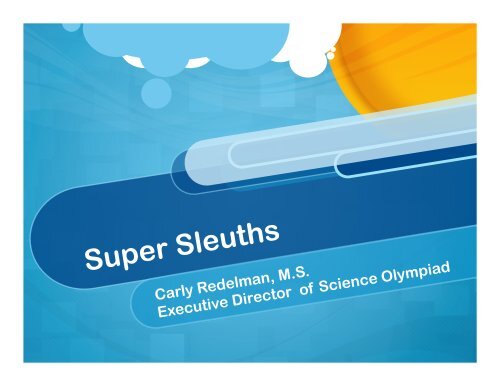


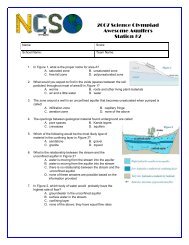
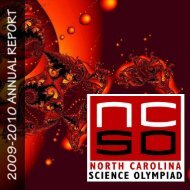

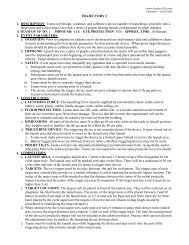
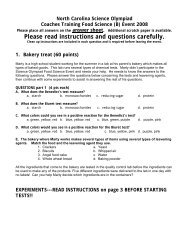

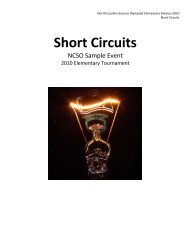
![Shock Value Practice Test[1].pdf - Science Olympiad Student Center](https://img.yumpu.com/42685889/1/190x245/shock-value-practice-test1pdf-science-olympiad-student-center.jpg?quality=85)



